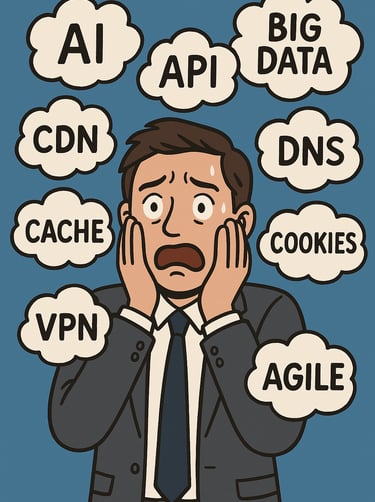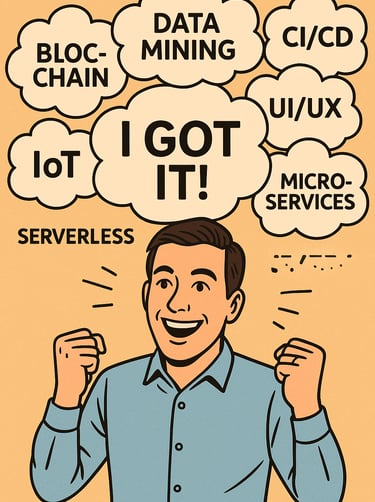Tech Talk for Product Managers: Explaining 40 Tech Concepts Without the Jargon.
Hi everyone! I’m Simran—a passionate product manager who loves making tech easy and fun for everyone. With a background in teaching and developing and a knack for breaking down complex ideas, I believe that understanding technology is like learning the rules of a new game—once you get it, everything becomes more exciting and approachable.
3/25/20257 min read


Let’s go deeper into core tech concepts — these are the things product folks often hear in engineering meetings and nod along politely 😅. But not you. Not anymore.
Frontend
The frontend is everything users interact with directly — buttons, layouts, colors, forms. It’s built using HTML, CSS, and JavaScript. Think of any app or website you use — the screens you tap or scroll through? That’s the frontend. For example, the login page on Netflix is a part of its frontend experience.Backend
The backend is the part of an app you don’t see — where data is processed and logic lives. It handles user accounts, payments, and more. When you book a ride on Uber, the backend confirms your request, matches you with a driver, and calculates your fare behind the scenes.API
An API (Application Programming Interface) lets two systems talk to each other. Think of it like a waiter who takes your order (request) to the kitchen and brings back the food (response). For example, when an app shows live weather, it’s using a weather API to fetch that info in real time.Cloud
Cloud computing is renting storage and processing power online instead of managing physical servers. Tools like Google Drive, Dropbox, or AWS store your data “in the cloud.” It lets companies scale faster, collaborate globally, and avoid managing infrastructure on their own.Database
A database stores and organizes information for fast retrieval. Think of user accounts, product listings, or messages in a chat app — all live in a database. Netflix stores user profiles and watch history in databases to personalize your viewing experience.DevOps
DevOps bridges development (building software) and operations (deploying and maintaining it). It focuses on automation, speed, and reliability. When Amazon rolls out frequent updates without downtime, that’s DevOps in action — with tools ensuring smooth builds, tests, and deployment.Encryption
Encryption scrambles data so only authorized parties can read it. It’s used in messaging apps like WhatsApp to ensure that only the sender and receiver can see the conversation. Even if someone intercepts the message, it looks like gibberish unless decrypted.Firewall
A firewall acts like a security gate between your device or network and the internet. It blocks suspicious or harmful traffic. In companies, firewalls prevent malware or hackers from entering internal systems through unsecured ports or rogue apps.VPN
A VPN (Virtual Private Network) creates a secure connection over the internet. It hides your IP address and encrypts your online activity. Employees working remotely often use VPNs to safely access internal tools without exposing the company’s network.Cookies
Cookies are small files stored by websites on your browser to remember things like login sessions, preferences, or items in your cart. When Amazon remembers what you added to your cart yesterday — that’s cookies at work. They help personalize the web experience.Cache
A cache is like a temporary storage that helps apps and websites load faster by remembering parts you’ve already seen. For example, when you revisit Instagram, it loads your profile quickly because images and data are cached locally.DNS
The Domain Name System (DNS) turns website names (like google.com) into IP addresses that computers understand. It’s like your phone’s contacts list — you tap “Mom,” but the phone dials a number behind the scenes. Without DNS, we’d type IPs instead of names.CDN
A Content Delivery Network (CDN) speeds up the loading of content (images, videos, files) by storing it across multiple global servers. If you’re in India and visit a US website, a nearby CDN server loads it faster. Netflix and YouTube use CDNs for smooth streaming.Version Control
Version control tracks changes to code so teams can collaborate without overwriting each other’s work. Tools like Git let you roll back to earlier versions if something breaks. It’s essential in fast-paced environments where multiple people work on the same product.Microservices
Instead of building one huge app, microservices break it into smaller, independent services that work together. Netflix uses microservices for things like recommendations, search, and billing — each runs separately, so if one breaks, the rest still work.Serverless
Serverless computing lets developers run code without managing servers. Cloud providers (like AWS Lambda) handle all the backend stuff. You just write the function, deploy it, and it scales automatically. Great for small tasks like sending emails or processing images.API Gateway
An API Gateway is the front door that manages and routes all API requests in a system. It handles things like rate limits, security, and analytics. If your app uses multiple microservices, the API gateway acts as the smart traffic controller in the middle.SaaS (Software as a Service)
SaaS means using software over the internet without downloading anything. Think Google Docs, Zoom, or Canva — you access them via your browser, and everything runs on someone else’s servers. It’s flexible, subscription-based, and doesn’t require you to manage updates.PaaS (Platform as a Service)
PaaS offers tools and infrastructure to developers so they can build apps without managing servers. Google App Engine or Heroku are good examples. It’s like renting a full kitchen — everything’s set up, so devs can focus on cooking (writing code), not fixing the stove.IaaS (Infrastructure as a Service)
IaaS provides raw computing resources — like storage, networking, and virtual machines. AWS EC2 and Microsoft Azure are examples. It’s like renting a blank piece of land (in the cloud) to build whatever system or app your team needs from the ground up.Server
A server is a powerful computer that stores and serves content when you visit a website or app. When you open Instagram, a server somewhere sends you your feed. Servers can be physical machines or cloud-based and are critical to making apps run smoothly.Latency
Latency is the delay between a user action and the system response. Ever clicked on something and it took a moment to respond? That’s latency. Lower latency = faster responses. It matters most in real-time apps like gaming, video calls, or stock trading platforms.SQL
SQL (Structured Query Language) is a language used to manage and retrieve data from structured databases. Say you're building a dashboard for a food delivery app — you’d use SQL to ask, “How many orders were placed in Bangalore last week?” and get accurate results.NoSQL
NoSQL databases handle unstructured or flexible data — like images, JSON files, or real-time feeds. MongoDB is a popular NoSQL option. Apps that need to scale fast and handle varied data types, like chat apps or recommendation engines, often go for NoSQL.Load Balancing
Load balancing spreads user requests across multiple servers to avoid overload. For example, during an IPL match, Hotstar uses load balancers to make sure millions of users don’t crash the app. It helps maintain speed and stability under heavy traffic.CI/CD (Continuous Integration/Continuous Deployment)
CI/CD automates the process of building, testing, and deploying code. It means updates reach users faster and with fewer bugs. Think of it like an assembly line where every feature is tested and deployed smoothly without manual delays — GitHub Actions and Jenkins are popular tools.Data Mining
Data mining is digging through large sets of data to find useful patterns or insights. For instance, Netflix uses data mining to analyze viewing habits and suggest shows. It helps companies make smarter decisions based on real user behavior.Bandwidth
Bandwidth is the maximum amount of data that can travel over a network in a given time. Higher bandwidth means faster downloads and smoother video calls. Think of it like a highway — more lanes = more traffic can pass through without delays.CMS (Content Management System)
A CMS lets people create and manage website content without needing to code. WordPress is a popular one. It’s ideal for blogs, portfolios, or news sites. Marketers and non-tech teams can publish and update content easily using a CMS.MVC (Model-View-Controller)
MVC is a way to organize code into three parts: the model (data), the view (UI), and the controller (logic). It keeps things clean and manageable. Developers use it in frameworks like Django or Rails to keep large applications organized and scalable.REST
REST (Representational State Transfer) is a common way for APIs to communicate. It follows simple rules — using URLs and standard methods (GET, POST, etc.). Most modern apps like Twitter or Slack use REST APIs to connect their frontend and backend.Containerization
Containerization packages code and its environment together so it runs the same everywhere. Docker is the most popular tool. Say your app works on your laptop but breaks on a server — containers solve that. Think of it like shipping goods in identical, sealed boxes.Kubernetes
Kubernetes is an orchestration tool for managing containers at scale. It decides where to run them, handles failures, and scales services up/down. Netflix, for example, runs tons of microservices — Kubernetes keeps everything humming behind the scenes.Webhooks
Webhooks are automated messages sent when something happens. They're like event-based APIs. For example, Stripe can notify your app instantly when a payment succeeds. It’s push vs. pull — you get the update without asking for it every 5 minutes.Reverse Proxy
A reverse proxy sits in front of servers and routes requests to them. It improves security, load balancing, and caching. NGINX is a common one. If 100 users hit your app at once, the reverse proxy figures out which server should handle each request.TLS/SSL
TLS (formerly SSL) encrypts data sent over the internet to keep it secure. It’s what makes that little padlock appear in your browser’s address bar. For example, when you shop on Amazon, TLS makes sure your credit card info isn’t exposed in transit.WebSockets
WebSockets allow two-way communication between a browser and server in real-time. Unlike normal HTTP requests, WebSockets stay open. Apps like WhatsApp use it so you see new messages instantly — no refreshing required.Rate Limiting
Rate limiting controls how many requests a user or system can make in a given time. It prevents abuse, like bots spamming a login form. Twitter’s API, for instance, has strict rate limits so apps don’t overload their systems with thousands of calls.Load Testing
Load testing simulates lots of users interacting with your app to see if it holds up under pressure. Before launching, companies like Zomato might simulate thousands of food orders to see when things crash — and fix weak spots.Kernel
The kernel is the core of an operating system. It manages hardware, memory, and process control. Think of it as the boss that decides which apps get access to the CPU or RAM. You don’t interact with it directly, but it keeps the system running smoothly.I hope this fun rundown helps you understand the tech lingo without feeling overwhelmed. Whether you’re chatting with developers or planning your next big product, these concepts are like secret tools in your toolkit. And remember, you don’t have to be a coding whiz to lead with tech-savvy insight—just a curious mind and a willingness to learn is plenty.
Happy product managing, and keep exploring the amazing world of technology!

